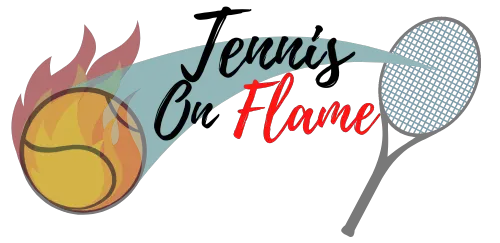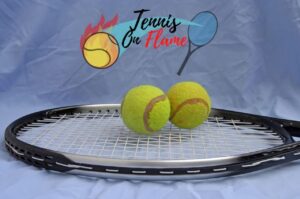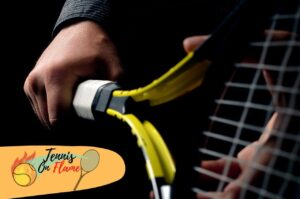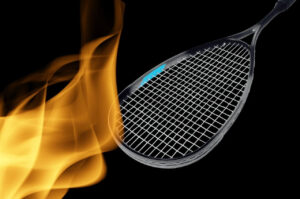If you’re a tennis player, it’s important to know the anatomy of your racket.
This way, you will be able to understand how each part works and how they affect your game.
we will take a deep dive into the anatomy of a tennis racket.
We will also explore the three key parts of a tennis racket – the head, shaft, and handle – and every part inside them and discuss how they impact your play.
So whether you are just starting in tennis or you are an experienced player, this blog post is for you-
Let’s get started on our journey to the anatomy of a tennis racket!
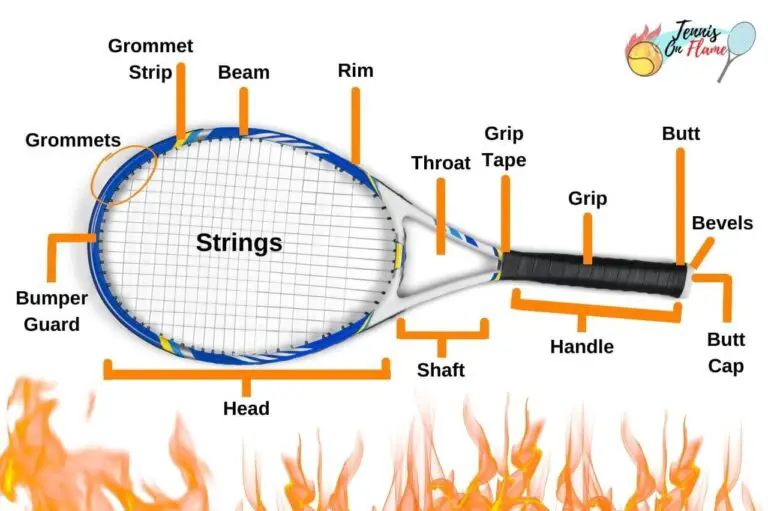
What are the parts of a tennis racket called?
Tennis rackets have 3 main parts:
The head, which is where you hit the ball; a handle that you hold in your hand and use to swing at it; and finally, – a shaft that connects those two pieces.
Let’s focus on each part and discuss what they do and which other parts you will find inside them-
The Head
As the name suggests, this is the biggest and most important part of your tennis racket.
This is where all the action happens – it’s where you hit the ball.
The size, shape, and stiffness of the head will affect how you hit the ball as well as how much power you can
The head of a tennis racket is made from graphite or carbon fiber, which gives it strength and durability.
It comes in different shapes and sizes depending on what type of player you are- for example:
If you like to play aggressively with power shots then having an oversized head would be good because it gives you more surface area to hit the ball with.
Conversely, if you are a defensive player who likes to use spin and control then a mid-sized head would be better for you.
Inside the head of your tennis racket, you will find:
The strings
These are what connect with the ball when you hit it and they come in different tensions, thicknesses, and materials.
There are three types of strings: natural gut, synthetic gut, and nylon.
Gut strings are made from animal intestines while synthetic gut and nylon strings are made from man-made materials.
All three have their benefits and drawbacks – for example, gut strings last longer but they don’t provide as much power as synthetic or nylon ones do.
You can also choose what kind of string pattern you want your racket to have- for example, a 16 x 19-inch racquet will give you more control than one with an 18 x 20-inch pattern because there are fewer holes in it (fewer holes = more strings in contact with the ball).
The bumper guard
This is a rubber piece that is found at the bottom of the head and its job is to protect the strings from being damaged when you hit the ball.
The grommets
These are holes in your racket head where the strings come through and they help protect them from getting damaged by other parts of your racquet such as the edge or bumper guard.
The grommet strip
This is a piece of metal or plastic that runs along the top of the grommets and it helps to protect them from getting damaged.
The grommet strips are usually made up of either aluminum or graphite.
Beam
This is the part of the head that connects the strings to the sides of the racket.
It’s usually made from either graphite or aluminum and it helps to transfer power from your arm to the ball.
Rim
The rims are the outer edges of the racket head frame.
They help to protect your strings and provide support for them when you are playing.
The Shaft
As we mentioned earlier, the shaft is the part of your tennis racket that connects the head to the handle.
It’s made from either graphite or aluminum and its job is to transfer power from your arm through the handle and then into the head where it hits the ball.
Inside the shaft you will find only one important part of a tennis racket:
Throat
This is the part of the shaft that connects it to the head and it’s where all the power from your arm is transferred.
The throat is the open portion of the racket positioned right below the head. you can see it easily by the big hole in the shaft.
The Handle
The handle is the part of your tennis racket that you hold in your hand.
It’s made from either wood or plastic and it provides you with a comfortable place to grip the racket.
Inside the handle, you will find:
The grip
This is the part of the handle that you hold onto with your hand.
It’s usually made from either wood or plastic and it provides you with a comfortable place to grip the racket.
Grip Tape
This is a piece of cloth or tape that wraps around the handle and it provides you with a comfortable place to grip the racket.
The butt cap
This is a piece of plastic or metal that covers the end of the handle and it helps to protect it from getting damaged.
Butt
While the butt cap is a plastic piece at the end of a racquet’s handle, the term “butt” refers to the bottom of the handle more generally.
Bevels
These are the edges of the handle that help to provide you with a more comfortable grip.
Related questions on the parts of tennis rackets
Here are some questions we got from our readers about the parts of tennis rackets:
What is the frame of a tennis racket?
The frame of a tennis racket is the part that you hit the ball with. It’s usually made from either graphite or aluminum and it helps to transfer power from your arm to the ball.
What’s the top of a tennis racket called?
The top of a tennis racket is the head, which is the part that you hit the ball with –
But if you are asking about the top of the head, this is called the tip.
What is the base of the racket?
The base of a tennis racket is called the butt and it is the bottom of the handle.
What is a tennis racket made of?
A tennis racket is made from a combination of materials including aluminum, graphite, and rubber.
The head is usually made from either graphite or aluminum while the handle is typically made from either wood or plastic.
How many holes does a tennis racket have?
A tennis racket typically has around 18-76 string holes.
These are used to attach the strings to the head of the racquet.
Grommets hold the strings in place and protect them from getting damaged by other parts of your racquet such as the edge or bumper guard.
What are the different tennis grips?
There are three main types of tennis grips: the Continental grip, the Eastern grip, and the Western grip.
Each one is a little different and provides you with a different level of control when playing.
What is a backhand grip?
A backhand grip is a grip that you use when playing a backhand shot.
It’s typically a Continental grip, which gives you more control over the ball.
What is a forehand grip?
A forehand grip is a grip that you use when playing a forehand shot.
It’s typically an Eastern grip.
What is a two-handed backhand grip?
A two-handed backhand grip is a grip that you use when playing a backhand shot with both hands on the racket.
It’s typically an Eastern or Western grip.
What is a volley grip?
A volley grip is a grip that you use when playing a volley shot. It’s typically an Eastern or Western grip.
What is a serve grip?
A serve grip is a grip that you use when playing a service shot. It’s typically an Eastern or Western grip.
What is racket tension?
Racket tension refers to the amount of force that’s placed on your strings by stringing them tightly or loosely around your frame.
The tighter you string your racket, the more power you’ll get from it but at a cost of less control over where the ball goes when hit with such tightness.
How would you describe a tennis racket?
A tennis racket is a long, narrow piece of equipment that is used to hit a ball.
It has a frame on one end and a handle on the other, with strings in between.
The head of the racket is where you hit the ball from, while the handle is used for holding it.
In conclusion
A tennis racket is an important piece of equipment for any player – that’s why it’s important to know the anatomy of a tennis racket.
It has 3 main parts – the head, shaft, and handle – each with its specific purpose.
Whether you’re just starting out or if you’ve been playing for years, having the right racquet can make all the difference when it comes to your game.
So take some time and think about what kind of player are you? What skill level do want to reach?
Are there any specific features that would help you achieve those goals?
Once you’ve figured out what kind of players are, then go shopping around and find yourself the perfect racket!
I hope you liked my post about the anatomy of a tennis racket.
If you have any questions, make sure to leave a comment on this post.
Good luck on your tennis journey – and remember to have fun!
